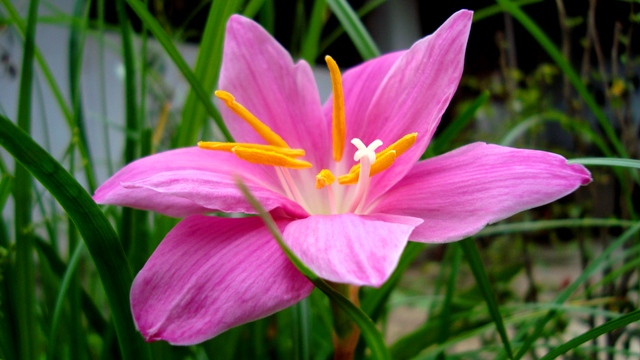Fairy Lily or White Rain Lily is also known as August rain lily, White zephyr lily, Peruvian swamp-lily, Zephyr flower, Autumn zephyr lily ,Autumn Rain-Lily, Flower-Of-The-Western-Wind, , Zephyr Lily and so sweetly called Rain flower .
Rainlily has nearly 70 species known in botanical nomenclature as Zephyranthes and Habranthus. All of them are flowering bulbs that share common names of rainlily, fairy lily, rainflower and zephyrlily. These flowers are commonly called rain lilies because they often bloom after it rains.
Rain lily flowers in spring, summer or fall, depending on species and garden conditions but especially after a shower. But most of these plants are spring or summer flowering. Each six-petalled, funnel-shaped flower is found atop a stem that ranges in height from 2 inches to more than 12 inches. This white cultivar of a flower is usually found in pink and also yellow forms. Leaves are a deep glossy green and measure 3 mm wide. The leaf-like bract is 1.8 to 4 cm. Each bulb produces clusters of dark-green, strap-like fleshy leaves up to 12 inches long. Bulbs rapidly form large clumps and can display up to 20 flowers at once. They grow best in sunny atmosphere (partial shade is also good) and they require a medium wet soil. The plant is drought tolerant and heat tolerant.
White Rain Lily can be grown more than any other species of Zephyranthes. Its Botanical name is Zephyranthes candida. The genus is native to the south eastern United States and South America. They look nice as garden or lawn borders like border of a saree. The White Rain Lily tolerates drought, heat and clay soils forming clumps about 12 inches tall and wide. In the early fall, it is covered with large white flowers. Plants are evergreen in winter.
Pink Rain lily Buds
The pink variety is called pink rain lily or rose pink zephyr lily and bears the Botanical name Zephyranthes rosea. It is native to Central America and the West Indies. It is most favoured of the genus. This rain lily produces bright-pink, funnel-shaped flowers all summer long. I have got one or two of them in my flower pot in my inner yard this July after monsoon shower. See them here.
The yellow variety is called Yellow Rain Lily, Yellow Fairy Lily, and Yellow Zephyr Lily. Its botanical name is Zephyranthes citrina (or sometimes sulphurea).The one-inch, lemon yellow flowers of this rain lily spring forth in late summer.
Rain lilies are easy to grow, don’t need much care, have a broad adaptability and beautiful flowers make it a gardener’s always favourite. They do well in pots, but not indoors. Keep the soil moist and feed monthly with a slow-release bio-fertilizers (cow dung is best) throughout the summer.
Most of these species when the flowers fade, they develop small capsules that contain plantable seeds. These shiny black seeds can be collected when the capsules mature and turn yellow and begin to split. Sow fresh seeds on a moist soil and lightly cover for a bit of warmth. In two to six weeks it will sprout. Under ideal conditions, seedlings will flower in eight to 12 months.
All the lilies of this species are a delight to the eyes. Make them a border for your lawn. No looker can help admiring them.






